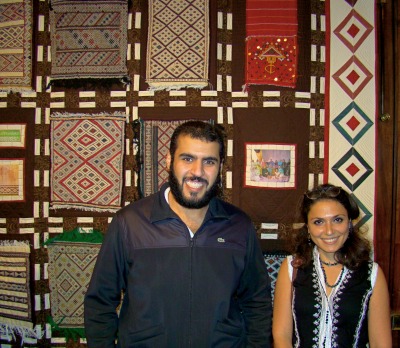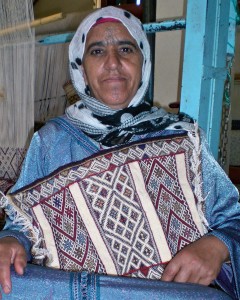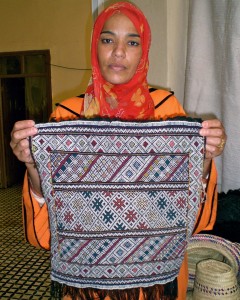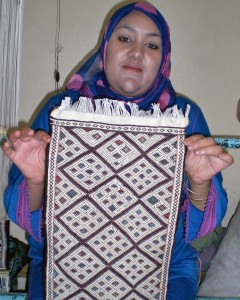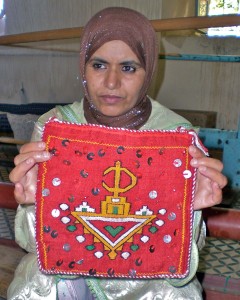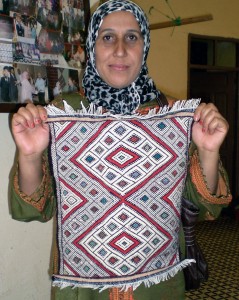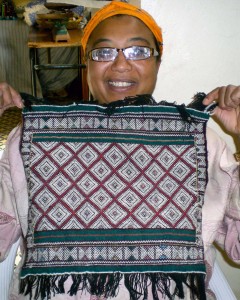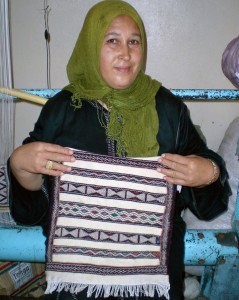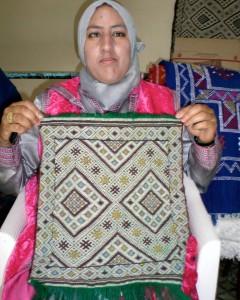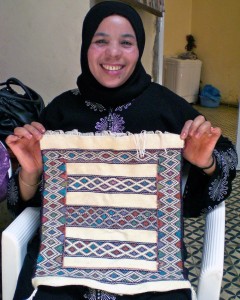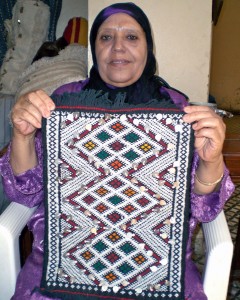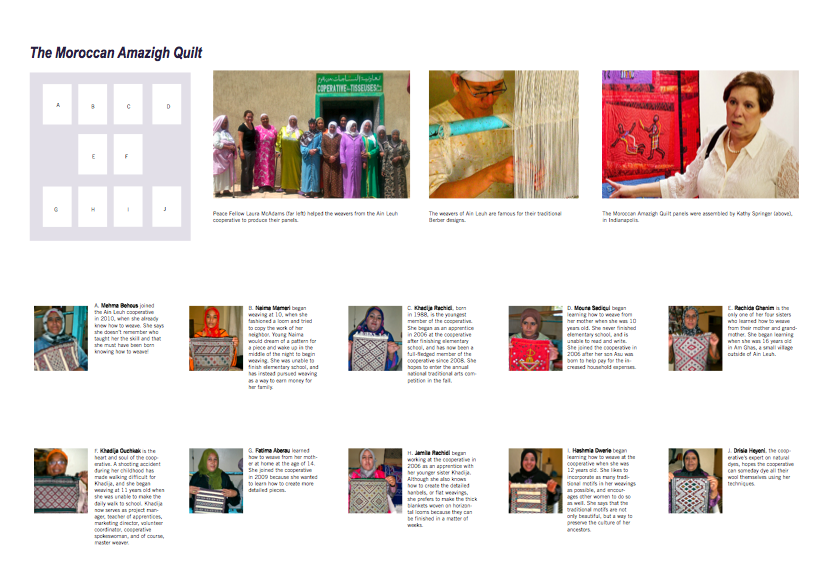The Moroccan Amazigh Quilt
Background
Background
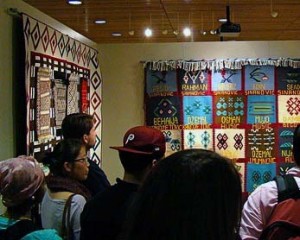 |
|
|
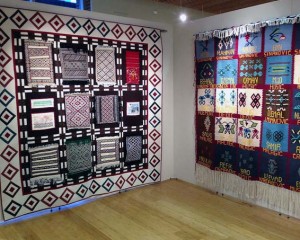 |
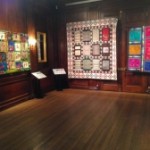 |
|
The Moroccan Amazigh Quilt (left) and Srebrenica Diaspora quilts. |
The Moroccan Amazigh Quilt (left) with the Diaspora Quilt (center) and the Ahadi (Promise) Quilts. |
Artists
Artists
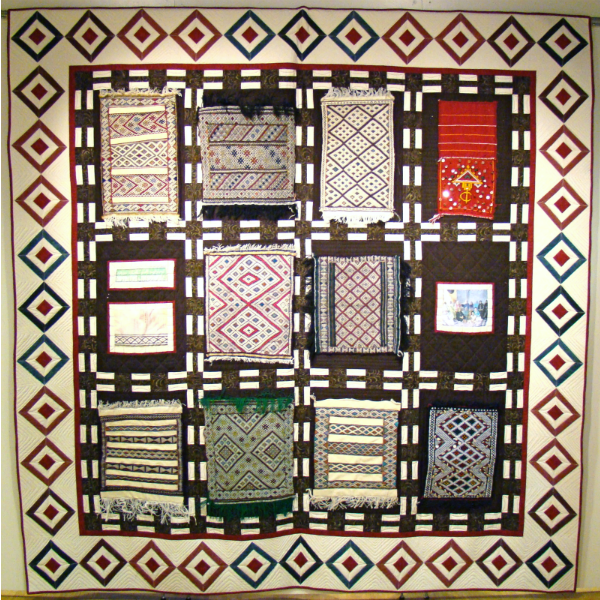 |
|
The following profiles of Ain Leuh weavers were written by 2012 Peace Fellow Laura McAdams. |
| Mehma Behous
Mehma Behous joined the Cooperative des Tisseuses d’Ain Leuh in 2010 already knowing how to weave. She says she doesn’t remember who taught her the skill; that she must have been born knowing how to weave. Although she now lives in Ain Leuh with her husband and son, Mehma was born and raised in Bou Harsh, a small village about 5 miles outside of Ain Leuh.Most of her extended family still lives there, tending to the family’s cherry orchards (40% of Morocco’s cherries come from the Ain Leuh region). She received the traditional Amazigh tattoos on her forehead and chin when she was married. She is somewhat embarrassed about them now, saying that she was tattooed before she knew it was forbidden (by Islam). She enjoys weaving at the cooperative more than in her home because she can talk and laugh with her friends while she works. |
|
Naima Mameri
Naima Mameri has always enjoyed weaving. She began as a self-taught weaver at 10 years old, when she fashioned herself a loom and tried to replicate the work of her neighbor. Noticing her talent and enthusiasm for the art, this neighbor sat with Naima and showed her the basic techniques of weaving. Young Naima would dream of a pattern for a piece and wake up in the middle of the night to begin weaving. Naima never finished elementary school, instead pursuing her weaving to earn money for her family. She moved from Souq al Had, a neighboring town, to Ain Leuh in 2000, and officially joined the cooperative in 2002. Now, she is married to Ghazi, a drummer who performs in a traditional Middle Atlas music group. They have two children, Shaima 13, and Fatima Zahra, 10. Fatima Zahra would like to learn how to weave and follow in her mother’s footsteps, but Naima has encouraged Fatma Zahra to continue studying instead. Naima believes that there is not enough economic opportunity in weaving to allow her daughter to become an apprentice. However, Naima still enjoys weaving because it gives her something to do when she is not taking care of her family and home, and is glad to be able to help pay for household expenses. |
|
Khadija Rachidi
Khadija Rachidi, born in 1988, is the youngest member of the cooperative. She began as an apprentice in 2006 at the cooperative after finishing elementary school, and has now been working as a full-fledged member of the cooperative since 2008. Khadija first tried working as a tailor, but was later drawn to the more traditional work of weaving. Khadija is a very talented young weaver, and hopes to enter the annual national traditional arts competition in the fall. She is single and lives at home with her older sister, Jamila, also a weaver at the cooperative, an older brother and their parents. |
|
Mouna Sadiqui
Mouna Sadiqui began learning how to weave from her mother when she was 10 years old. She never finished elementary school, and is unable to read and write. She joined the cooperative full time in 2006 after her son Asu was born to help pay for the increased household expenses. Her and her family all speak Tamazight at home and she is very proud of her Amazigh heritage. To communicate this pride to the world, she has decided to create this untraditional square, which features the regional symbol of the Amazigh people with metal sequins, typical to middle atlas weavings. |
|
Rashida Ghanim
Rashida Ghanim is the only one of her four sisters who learned how to weave from their mother and grandmother. She began learning when she was 16 years old in Am Ghas, a small village outside of Ain Leuh. She moved to Ain Leuh when she was married in 2006, and joined the cooperative in 2010. Her husband, Mahjoub, is unemployed, and Rashida is thankful she is able to earn a living for the both of them at the cooperative by doing work she already knows and loves. She hopes to someday have many children. |
|
Khadija Oujkak
Khadija Oujkak is the heart and soul of the cooperative. A misplaced shot in the hip during her childhood has rendered walking difficult for Khadija. She began weaving at 11 years old when she was unable to make the daily walk to school. She joined the cooperative in 1983 and became treasurer in 2000. Her unofficial titles now include project manager, teacher of apprentices, marketing director, volunteer coordinator, cooperative spokeswoman, and master weaver. Her husband, Mohamed, lives and works in nearby Azrou where he makes svinj, Moroccan donuts. They have two children, Nadia, 17 who wishes to someday join the police force, and Mehdi, 7 who loves to sing and dance. |
|
Fatima Aberau
Fatima Aberau learned how to weave from her mother at home when she was 14 years old. She decided to join the cooperative in 2009 because she wanted to learn how to create more detailed pieces. She also enjoys socializing while weaving. Fatima has two sons, Mehdi, 18 and Ahmed, 14. Her mother is no longer able to weaves because of her poor eyesight. Instead, she buys sheared wool from the souq for about 25 cents a pound, washes and spins it, and sells it to the cooperative for $1.50 a pound. |
|
Jamila Rachidi
Jamila Rachidi began at the cooperative in 2006 as an apprentice with her younger sister Khadija. Although she also knows how to create the detailed hanbels, or flat weavings, she prefers to make the thick blankets woven on horizontal looms because they can be finished in a matter of weeks, rather than a matter of months like the flat weavings. Her sister-in-law just gave birth and Jamila is looking forward to filling in as the child’s nanny when her mother returns to work in the fall as a teacher at the elementary school. |
|
Hashamia Dwerie
Hashamia Dwerie, born and raised in Ain Leuh, began learning how to weave at the cooperative in 1978 when she was 12 years old, dropping out of elementary school to begin earning an income, and joined the cooperative when it was founded in 1979. She likes to incorporate as many traditional motifs in her weavings as possible, and encourages other women to do so as well. She says that the traditional motifs are not only beautiful, but a way to perpetuate the culture of her ancestors. Her husband passed away in 2005, so Hashamia now has to support herself and two of her three children by herself. In addition to being one of the master weavers at the cooperative, Hashamia works in the fields that surround Ain Leuh. Most recently, she earned 80 dirhams a day, about $9.50 picking cherries, and will work in the apple orchards in the fall. |
|
Drisia Heyeni
Drisia Heyeni, unlike most of the cooperative’s members, learned how to weave after she had married and raised her children. She lived across from the cooperative and was interested in learning how to weave after watching the women at work. She enjoyed their company so much she was convinced to join the cooperative in 1997. She is now the cooperative’s expert on natural dyes, having attended a week-long conference on learning the processes and natural materials to dye wool in 2007. She hopes the cooperative can someday dye all their wool themselves using these techniques. Drisia has five children, three of whom live and work in Tangier and regularly send money home to Ain Leuh. She also owns an apiary in nearby Toufsilt and harvests honey once a year to help supplement her income. |
|
Quilt photos and text by Laura McAdams |

